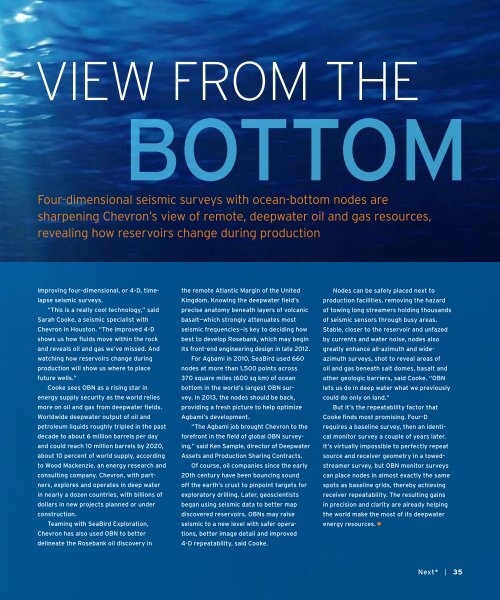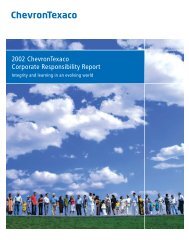Next* Magazine, Issue 5 - Chevron
Next* Magazine, Issue 5 - Chevron
Next* Magazine, Issue 5 - Chevron
Create successful ePaper yourself
Turn your PDF publications into a flip-book with our unique Google optimized e-Paper software.
View From the<br />
bottom<br />
Four-dimensional seismic surveys with ocean-bottom nodes are<br />
sharpening <strong>Chevron</strong>’s view of remote, deepwater oil and gas resources,<br />
revealing how reservoirs change during production<br />
improving four-dimensional, or 4-D, timelapse<br />
seismic surveys.<br />
“This is a really cool technology,” said<br />
Sarah Cooke, a seismic specialist with<br />
<strong>Chevron</strong> in Houston. “The improved 4-D<br />
shows us how fluids move within the rock<br />
and reveals oil and gas we’ve missed. And<br />
watching how reservoirs change during<br />
production will show us where to place<br />
future wells.”<br />
Cooke sees OBN as a rising star in<br />
energy supply security as the world relies<br />
more on oil and gas from deepwater fields.<br />
Worldwide deepwater output of oil and<br />
petroleum liquids roughly tripled in the past<br />
decade to about 6 million barrels per day<br />
and could reach 10 million barrels by 2020,<br />
about 10 percent of world supply, according<br />
to Wood Mackenzie, an energy research and<br />
consulting company. <strong>Chevron</strong>, with partners,<br />
explores and operates in deep water<br />
in nearly a dozen countries, with billions of<br />
dollars in new projects planned or under<br />
construction.<br />
Teaming with SeaBird Exploration,<br />
<strong>Chevron</strong> has also used OBN to better<br />
delineate the Rosebank oil discovery in<br />
the remote Atlantic Margin of the United<br />
Kingdom. Knowing the deepwater field’s<br />
precise anatomy beneath layers of volcanic<br />
basalt—which strongly attenuates most<br />
seismic frequencies—is key to deciding how<br />
best to develop Rosebank, which may begin<br />
its front-end engineering design in late 2012.<br />
For Agbami in 2010, SeaBird used 660<br />
nodes at more than 1,500 points across<br />
370 square miles (600 sq km) of ocean<br />
bottom in the world’s largest OBN survey.<br />
In 2013, the nodes should be back,<br />
providing a fresh picture to help optimize<br />
Agbami’s development.<br />
“The Agbami job brought <strong>Chevron</strong> to the<br />
forefront in the field of global OBN surveying,”<br />
said Ken Sample, director of Deepwater<br />
Assets and Production Sharing Contracts.<br />
Of course, oil companies since the early<br />
20th century have been bouncing sound<br />
off the earth’s crust to pinpoint targets for<br />
exploratory drilling. Later, geoscientists<br />
began using seismic data to better map<br />
discovered reservoirs. OBNs may raise<br />
seismic to a new level with safer operations,<br />
better image detail and improved<br />
4-D repeatability, said Cooke.<br />
Nodes can be safely placed next to<br />
production facilities, removing the hazard<br />
of towing long streamers holding thousands<br />
of seismic sensors through busy areas.<br />
Stable, closer to the reservoir and unfazed<br />
by currents and water noise, nodes also<br />
greatly enhance all-azimuth and wideazimuth<br />
surveys, shot to reveal areas of<br />
oil and gas beneath salt domes, basalt and<br />
other geologic barriers, said Cooke. “OBN<br />
lets us do in deep water what we previously<br />
could do only on land.“<br />
But it’s the repeatability factor that<br />
Cooke finds most promising. Four-D<br />
requires a baseline survey, then an identical<br />
monitor survey a couple of years later.<br />
It’s virtually impossible to perfectly repeat<br />
source and receiver geometry in a towedstreamer<br />
survey, but OBN monitor surveys<br />
can place nodes in almost exactly the same<br />
spots as baseline grids, thereby achieving<br />
receiver repeatability. The resulting gains<br />
in precision and clarity are already helping<br />
the world make the most of its deepwater<br />
energy resources. ■<br />
<strong>Next*</strong> | 35

















